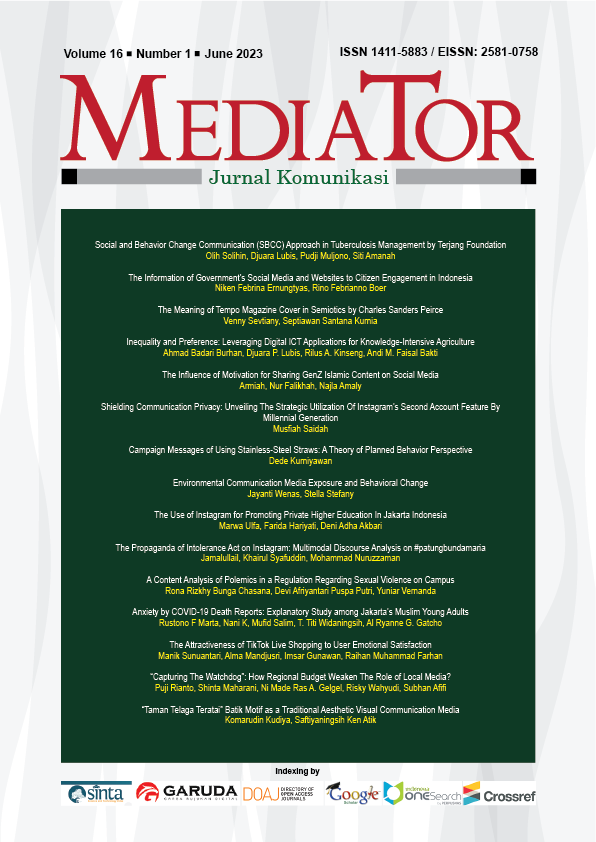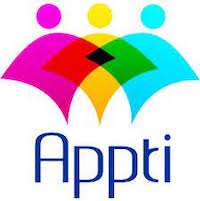Environmental Communication Media Exposure and Behavioral Change
DOI:
https://doi.org/10.29313/mediator.v16i1.2177Keywords:
campaign, hashtag, instagram, followers behaviorAbstract
A high amount of plastic waste and its threats to the environment and living things have become a major concern for many countries. One of the causes is the widespread use of single-use plastic bags in our everyday lives. Various studies have examined the negative impacts of plastic waste, and many environmental activists have responded to this global concern. Seasoldier is a community that has been conducting a digital campaign by utilizing the hashtag #Seasoldier to encourage followers to reduce their use of plastic bags. This study aims to determine the correlation between media exposure of #SeaSoldier on Instagram and behavioral change in their followers, and to examine the Media Ecology theory in an environmental communication context. A purposive sampling technique was applied to obtain respondents who met the following criteria: having an Instagram account and being an active follower of Seasoldier. The result of this study indicates a positive and strong correlation between the use of the hashtag feature and behavioral change, with a correlation coefficient value of r=.776 and a coefficient determination value of r2=.598, which defines 59.8% of the hashtag campaign exposure as leading to changes in followers’ behavior. Future research can develop broader research on the factors influencing follower behavior using qualitative methods.
References
Arikunto, S. (2013). Prosedur Penelitian: Suatu Pendekatan Praktik. Jakarta: Rineka Cipta.
Arinta, N. (2016, Januari 7). Antara Kita, Plastik, dan Lingkungan. Retrieved from WWF: https://www.wwf.or.id/ berita_fakta/blog/?44982/antara-ki¬ta-plastik-dan-lingkungan
Baran, S. J., & Davis, D. K. (2018). Teori Ko¬munikasi Massa edisi 5. Jakarta: Sa¬lemba Humanika.
Brink, H., Walt, C. V., & Rensburg, G. V. (2009). Fundamental of Research Methodology for Health Care Profes¬sionals. Cape Town: Juta and Compa¬ny Press.
Brodie, R. J., Hollebeek, L. D., Juric, B., & Ilic, A. (2011). Customer Engagement: Conceptual Domain Fundamental Propositions & Implications for Re¬search in Service Marketing. Journal of Service Research, 258.
Cain, S. D. (2019). From retweets to revo¬lution: Evaluating planned behavior within hashtag activism. IOWA State University Digital Repository, 4.
Chau, M. Q., Hoang, A. T., Truong, T. T., & Nguyen, X. P. (2020). Endless story about the alarming reality of plastic waste in Vietnam. Energy sources, part A: Recovery, utilization, and environ-mental effects, 1-9.
Chen, H. L., Nath, T. K., Chong, S., Foo, V., Gibbins, C., & Lechner, A. M. (2021). The plastic waste problem in Malaysia: management, recycling and disposal of local and global plastic waste. SN Ap¬plied Sciences, 3, 1-15.
Cialdini, R. B. (2007). Influence: The Pschol¬ogy of Persuasion. New York: Collins Bussiness
Cresswell, J. W. (1994). Research Design: Qualitative and Quantitative Ap¬proaches. Thousand Oaks California: Sage.
Creswell, J. (2005). Educational Research: Planning, conducting, and evaluating quantitative and qualitative research. New Jersey USA: Pearson Education Ltd
Etikan, I., Musa, S. A., & Alkassim, R. S. (2015). Comparison of Convenience Sampling and Purposive Sampling. American Journal of Theoretical and Applied Statistics, 1.
Ganczewski, G., & Jemielniak, D. (2022). Twitter is garbage: A Thick Big Data exploration of# zerowaste hashtag on Twitter in relation to packaging and food packaging materials. Packaging Technology and Science, 35(12), 893- 902.
Gay, L. P., & Airasian, P. W. (2000). Edu¬cational Research: Competencies for analysis and application (6th ed.). Up¬per Saddle River: Prentice Hall
Gideon, A. (2021, Januari 11). Ekonomi: Jumlah Sampah Plastik Melonjak sela¬ma Pandemi Covid-19. Retrieved from Liputan6.com: https://www.liputan6. com/bisnis/read/4454386/lipi-jum¬lah-sampah-plastik-melonjak-sela¬ma-pandemi-covid-19
Goswami, M. P. (2018). Social Media and Hashtag Activism. Liberty Dignity and Change in Journalism, 252-262
Heale, R., & Twycross, A. (2015). Validity and Reliability in Quantitative Studies. Evidence Based Nursing 18, 66-67.
Heidbreder, L. M., Lange, M., & Reese, G. (2021). #PlasticFreeJuly–Analyzing a Worldwide Campaign to Reduce Single-use Plastic Consumption with Twitter. Environmental Communica¬tion, 15(7), 937-953.
Heryana, A. (2020). DESAIN PENELITIAN NON EKSPERIMENTAL. Research Gate, 1
Hollebeek, L. D., Brodie, R. J., & Glynn, M. (2014). Consumer Branded #Hashtag Engagement: Can Creativity in TV Advertising Influence Hashtag En¬gagement? Science Direct: Interactive Marketing
Hornik, R. C. (2002). Public Health Com¬munication Evidence for Behavior Change. Mahwah, New Jersey: Law¬rence Erlbaum Associates Publishers.
IUCN.org. (2018, May). Issue Briefs. Re¬trieved from IUCN.org: https://www. iucn.org/resources/issues-briefs/ma¬rine-plastics
Jambeck, J., Hardesty, B. D., Brooks, A. L., Friend, T., Teleki, K., Fabres, J., ... & Wilcox, C. (2018). Challenges and emerging solutions to the land-based plastic waste issue in Africa. Marine Policy, 96, 256-263.
Kadir. (2015). Statistik Terapan : Konsep, Contoh dan Analisis Data dengan Pro¬gram SPSS/Lisrel dalam Penelitian. Jakarta: Rajawali Pers
Karuniastuti, N. (2013). Bahaya Plastik Ter¬hadap Kesehatan Dan Lingkungan. E journal ppsdm migas swara patra, 3.
Mosler, H. J., & Contzen, N. (2016). Sys¬temic Behavior Change in Water San¬itation and Hygiene- Practical Guide Using the RANAS Approach. Eawag Aquatic Research, 7-8.
Neuman, L. W. (2000). Social Research Methods: Qualitative and Quantitative approachs. Boston: Allyn and Bacon
Nurudin. (2017). Pengantar Komunikasi Massa. Jakarta: PT Rajagrafindo Per¬sada.
Putri, C. E., Damayanti, N., Hamzah, R. E. (2020). Sadfishing Phenomenon of #Justiceforaudrey (Hashtag) on Twit¬ter. Mediator: Jurnal Komunikasi, No.1, Vol.13.
Rizaty, M. A. (2021, Agustus 8). Inilah Neg¬ara Pengguna Instagram Terbanyak, Indonesia Urutan Berapa? Retrieved from databoks katadata: https:// databoks.katadata.co.id/datapub-lish/2021/08/03/inilah-negara-peng¬guna-instagram-terbanyak-indone¬sia-urutan-berapa
Sarana Multi Infrastuktur. (2018). Pengelo¬laan limbah. Insight SMI. Retrieved from ptsmi.co.id: https://ptsmi.co.id/ id/smi-insights
Saxton, G. D., Niyirora, J. N., Guo, C., & Waters, R. D. (2015). #Advocating¬ForChange: The Strategic Use of Hashtags in Social Media Advocacy. USF Scholarship: Digital Repository Gleeson Library, 155.
Scolari, C. A. (2012). Media ecology: Ex¬ ploring the metaphor to expand the theory. Communication theory, 22(2), 204-225.
Shuttleworth, M. (2009, April 26). Internal Consistency Reliability. Retrieved from Explorable.com: https://explor¬able.com/internal-consistencyreliabil¬ity
Stathopoulou, A., Borel, L., Christodoulides, G. and West, D. (2017), Consumer Branded #Hashtag Engagement: Can Creativity in TV Advertising Influ¬ence Hashtag Engagement?. Psychol. Mark., 34: 448-462
Sudarno. (2016). Dasar-dasar Statistika. Semarang: Departemen Ilmu Perpus¬takaan Fakultas Ilmu Budaya Univer¬sitas Diponogero.
Sugiyono. (2013). Metode Penelitian Kuanti¬tatif, Kualitatif, dan R & D. Bandung: Alfabeta.
Supriadi, Yadi. (2017). Komunikasi Politik DPRD Dalam Meningkatkan Peran Legislasi Di Kota Bandung. Mediator: Jurnal Komunikasi, No.1, Vol.10, 25- 36.
Claes H. de Vreese & Peter Neijens (2016). Measuring Media Exposure in a Changing Communications Envi¬ronment, Communication Methods and Measures, 10:2-3, 69-80, DOI: 10.1080/19312458.2016.1150441
West, R., & Turner, L. H. (2014). Introducing Communication Theory: An Analysis and Application, 5th Ed. New York: McGraw-Hill.
Wijayanto, T. (2018, Desember 11). Upa¬ya Pemerintah dalam Menangani Isu Sampah Plastik. Kompasiana.com: https://www.kompasiana.com/nowi¬jayanto/5c0fd1bb12ae943989443c74/ upaya-pemerintah-dalam-menan¬gani-isu-sampah-plastik?page=2
Downloads
Published
Issue
Section
License
Copyright (c) 2023 Author

This work is licensed under a Creative Commons Attribution-ShareAlike 4.0 International License.























